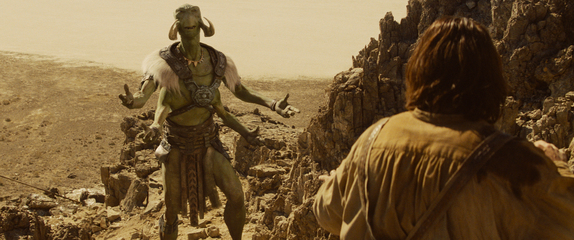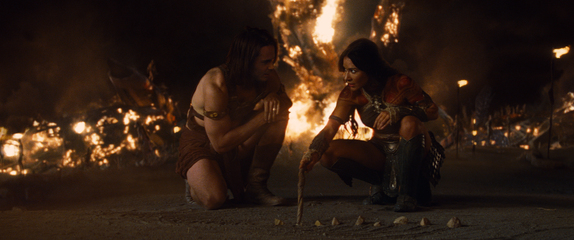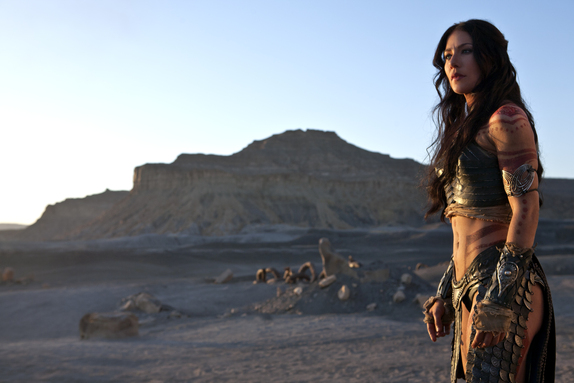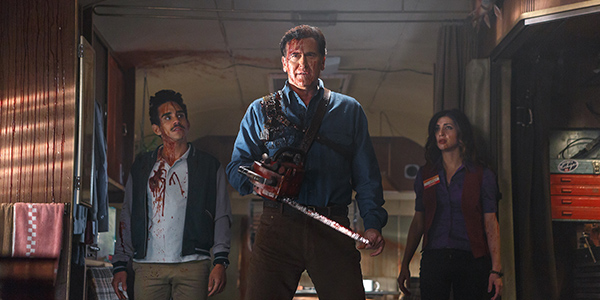Who is JOHN CARTER?
As I’m typing this, our own Jason Hunt sits in a movie theater, watching the new film from Disney, JOHN CARTER.
You’ll be seeing a review from both of us after the weekend, where we’ll dive into the good, the bad, and the “Wha?” of this big screen adaptation of Edgar Rice Burroughs’ A Princess Of Mars – one of the “Wha?’s” we’ll cover is the ad campaign, which may be why you might not have seen this film yet – but first, let’s take a few minutes to talk about who and what JOHN CARTER is, and why you should see it.
In 1911, Edgar Rice Burroughs was married with 2 children, and working at a stationery company. This wasn’t the most regular work, and he found himself with a lot of free time. To fill it, he began reading pulp fiction magazines. “The Pulps” were cheap magazines, usually about 120 pages or so, filled with sensational tales of love and adventure, horror and mystery. A lot of the stories were really terrible, but the writers worked cheap, you could get them out in a very short period of time, and at 10 cents, they were immensely popular.
Burroughs was pretty sure that he could write just as bad, if not better, than a lot of the authors in the pulps, and since he needed the money and had the time to try, he set out to tell a story. By the time he submitted the first part of what was then called “Dejah Thoris, Martian Princess” to The All-Story magazine that fall, he had only told his wife what he was trying to do, afraid that if anyone found out it could harm future business opportunities. The editor accepted it, made the kind of changes and suggestions editors like to make, and in February 1912, the first part of the novel was serialized under the title “Under the Moons of Mars”. Within two years, Burroughs would be immensely popular, and the serialized novel would be published as an actual book, titled A Princess of Mars.
By the way, if you aren’t that familiar with A Princess of Mars or any of the other books in the Barsoom series, but recognize the name Edgar Rice Burroughs, it’s probably because you know the series that he wrote about a certain Lord Greystoke. The publication of Tarzan of the Apes in 1912 cemented Burroughs’ fame, and would lead to many films, books, and comics all based on the famous Ape-man.
“But wait,” you say, “of course I’ve heard of Tarzan, who hasn’t heard of Tarzan? But this John Carter fellow, ehhh, hmmm. Not sure I know much about him.” Actually, looking out at our fine reading audience, a LOT of you probably do know who John Carter is. But unlike Tarzan, John Carter hasn’t had the media exposure that would lead to household name status, although scores of writers and films have been influenced by the adventures of that Virginian veteran.
But who is this John Carter?
Well, in brief, Carter is a former soldier of the Confederacy, prospecting for gold in Arizona after the war. When he finds himself fleeing the Apache, he stumbles into a mysterious cave and is transported to Mars. There he finds adventure and love; the first with the four-armed, giant Green Martians, and the second, and even more adventure, with the beautiful Dejah Thoris, Princess of Helium. Dejah Thoris is one of the Red Martians, human in appearance, and while she will sometimes need to be rescued by Carter (this was the 1910’s after all), she is an adventurer and heroine in her own right.
On Mars, Carter would find that the lower gravity made him immensely strong and able to leap incredible distances, sort of like the way Superman would appear in his earliest appearances. This would come in handy against the many foes he and Dejah Thoris would face, and between the two of them, often with the noble savage Tars Tarkas of the Green Martians, then later in tales of their children, they would go on to have many adventures over 11 novels.
Carter’s Mars, or Barsoom as the natives call it, is a dying world, where the oceans have dried up and the atmosphere is maintained by giant machines. The science, obviously wrong by today’s standards, was influenced by the theories of Percival Lowell, the astronomer who thought he saw canals on Mars, and Burroughs was more concerned with telling a thrilling story than keeping up with the latest science. It is, by the way, one of the things I really liked about the new film, as the filmmakers made no attempt to update the science, leaving Carter’s Mars a realm of monsters and aliens that exists alongside our Earth.
Interestingly, Carter was described by Burroughs as immortal in the early pages of A Princess of Mars, with no memory of a life before he was 30. Also interesting is the fact that Burroughs was a character in the book himself, with Carter being an old family friend called “Uncle Jack”, and stating that the book was a manuscript Carter had given him to publish after 21 years. Several of the later books would also have Burroughs repeat that role, claiming that the stories were given to him by Carter as he moved between Earth and Barsoom.
The Barsoom books and the adventures of John Carter have been immensely influential with writers and filmmakers, even if we’ve had to wait until now for a big budget Hollywood film version. Oh yes, there was a straight to video version from the Asylum studios a few years back, tied in to the release of Avatar, but aside from a surprisingly strong performance from Traci Lords, there’s not much to offer there, and the changing of the setting to the modern-day, and it’s obviously low-budget, strips the story of some of it’s most interesting aspects. It’s out there if you want to watch it, but I can’t recommend it.
Among the authors who happily admit to owing a debt to Burroughs’ A Princess of Mars are such names as Arthur C. Clarke, and Ray Bradbury, whose own The Martian Chronicles uses the dying Mars setting. Robert Heinlein would name characters after Carter and Dejah Thoris, and weave them into his series of intertwined stories. H.P. Lovecraft would find inspiration in Burroughs and Lord Dunsany. Robert E. Howard of Conan fame, Michael Moorcock and Philip Jose Farmer and many, many more would be influenced by and reference the adventures of John Carter. Those who have read Alan Moore’s The League of Extraordinary Gentlemen will recognize a version of Carter in the second volume.
But why have we had to wait so long for a quality film version? Well, in some ways we haven’t. James Cameron claims that Avatar is inspired by Burroughs books, and Buck Rogers is, in many ways, clearly inspired by John Carter. Star Wars shows the influence of the Barsoom books in a host of ways, but somehow, a film never quite materialized. Oh, there have been attempts, certainly. In the 1930’s, Bob Clampett of Looney Tunes fame tried to get an animated film made, but aside from some amazing test footage, the project never was completed. In the 50’s, Ray Harryhausen wanted to do a film version using his famous stop-motion animation for the alien creatures that inhabit Mars, which would have likely been fantastic, and then in the 80’s, a Disney version starring Tom Cruise was proposed, but the technology wasn’t yet good enough to make the completely alien world believable.
The rise of green screen and digital technology led Paramount to try and make a version, with Robert Rodriguez to direct, but the fallout of Rodriguez leaving the Director’s Guild led the film to move into the hands of Jon Favreau. When that project stalled, Paramount let the rights to the material expire, and Disney reacquired them, leading to the film in theaters now.
So why should you go see it? Well, as I wrote before, Mr. Hunt and I will give you a full review after the weekend, but here’s a few reasons to make your way to the cinema.
- It’s a piece of science fiction history. The influence is enormous, and the adaptation is pretty faithful. There have been changes of course, with some streamlining and some shuffling of events to tell a more coherent story, but so much of the original story is there that as far as adaptations go, this one is a winner.
- It has a strong female lead! Yes, John Carter saves Dejah Thoris a few times, it’s true. But she’s a smart, capable and brave woman, a true Princess of Mars, who wields a sword as well as any man, and is more than an equal to our hero.
- It’s gorgeous. The world-building here is truly excellent, from the alien landscape, the non-human inhabitants and their cities and the flying ships.
- Most important of all? It’s a good story, and quality science fantasy, and we should all be supporting that. It’s had a soft opening, which can be laid at the feet of the advertising campaign, and we’ll talk more about that in the review, but like every big budget film, it needs to make a profit for there to be a sequel.
And this one deserves a sequel folks.
(By the way, in the interests of full disclosure, a friend of mine has a small part in the new film, in an early scene set on Earth. Watch for the rough-looking fellow on the left who makes the mistake of attacking Carter. That’s Mr. Jared Cyr, who’s quite good and should be cast in many films. Just sayin’.)







I sense that you have mixed feelings about the results of this film.
I look forward to the review from you and Mr. Hunt.